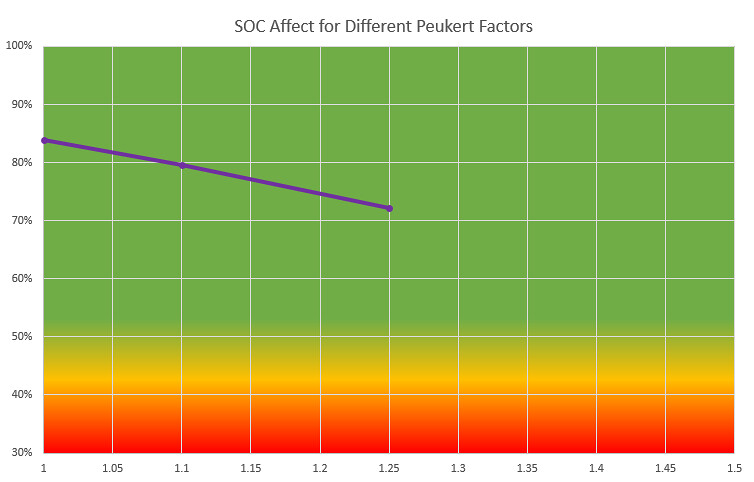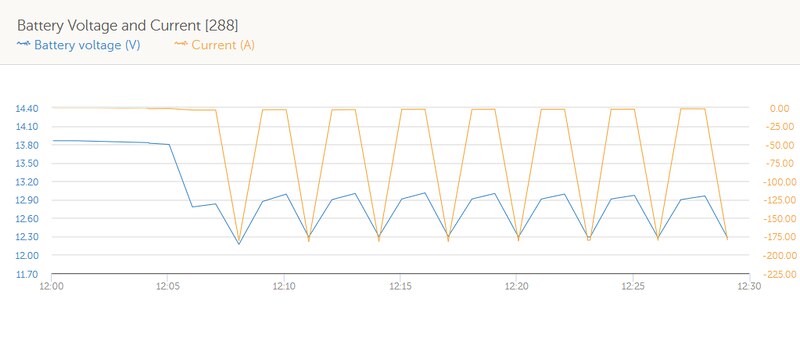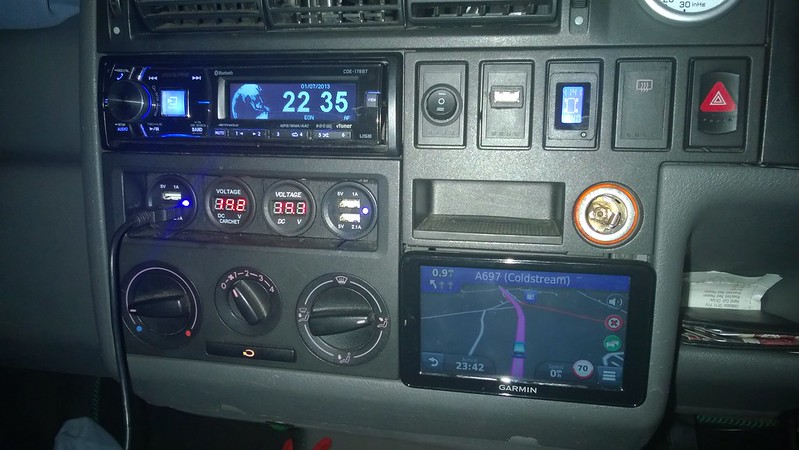I had missed your more recent post and can see that 1.25 might be high, I will be interested to see your results at 1.1.
Done the tests at 1.1 now

The water in the heater tank will be different to the first test so the actual run time will be different. While the heater is on, the power drawn is the same though so we can just use maths to do the check and comparisions.
Quick reminder and some initial set points ...
Battery Bank is set at 380Ah@C20 (4 batteries at 95Ah each).
Quick recap on this @Cxx value. What this is saying that how much capacity the
battery has for a different current draw. So a 110Ah
battery @ C100 means if you pull 1.1A for 100 Hours, it will give 110Ah. And 95Ah@C20 means if you pull 4.75A for 20 Hours, it will give only 95Ah due to the higher current - this is the Peukert effect.
Batteries are fully charged and SOC is reading 100% at the start of each test.
Apart from heater (and
inverter), the other load is a
Victron Inverter driving a Network router and an amp or so being pulled.
The Water Heater is setup that it is on a 60 second ON, 120 second OFF repeat cycle.
When the Heater is ON, there is a pull of 180A from the
battery for one minute. If we just take the
battery as a constant 12V for the purpose of the calculations, then each ON period means 3Ah taken out the batteries (180A/60)
From Cold, the heater is always on for over an hour to get to max temp, so I took the charts and after exactly 1 hour running (20 ON periods and 20 OFF periods), cross-referenced against the monitor provided SOC reading
For Peukert Factor set at 1.25
Power Drawn is 20*3Ah = 60Ah
SOC is 72.2%
This gives the
Battery Bank as having a Effective Capacity of 216Ah - so 54Ah per
battery if we look at a per
battery view
The
Battery is quoted as 110Ah@C100 & 95Ah@C20, and would be 54Ah@C3.6 i.e. if you had a constant load of 15A it would last 3.6 Hours until totally depleted.
For Peukert Factor set at 1.1
Power Drawn is 20*3Ah = 60Ah
SOC is 79.6%
Now this gives the
Battery Bank as having a Effective Capacity of 280Ah this time - so 70Ah per
battery if we look at a per
battery view. A signficant difference.
The
Battery is quoted as 110Ah@C100 & 95Ah@C20, and this time would be 70Ah@C4.7 i.e. if you had this constant load of 15A it would last 4.7 Hours until totally depleted.
For Peukert Factor set at 1.0 (i.e. None). Now this one is purely calculated and I *think* you would see if you were setup for a Lithium
Battery config in the monitor.
The calculation would be:
Power Drawn is 20*3Ah = 60Ah
The SOC with no Peukert Factor would be 84%
as there is no Peukert Factor the
battery would remain at 95@C6.3 i.e. with a constant load of 15A, the
battery would last 6.3 Hours until dead.
the "C" number varies as does the capacity for each of our examples - reason is that our Load is constant (this 15A per
battery per hour) and what that does to the
battery changes depending on the Peukert factor - and the 'rules' say that the correct Peukert factor varies depending on the
battery technology.
So for our constant load, our 95Ah@C20
battery changes as follows
1.25 Peukert - 54Ah@C3.6
1.1 Peukert - 70Ah@C4.7
1.0 Peukert - 95Ah@C6.3
Which is right? who knows

Oktas comment about
Victron Products is spot on and I am not dimissing them at all (quite the contrary - they are my 'go to' manufacturer where possible). I just have my doubts that so much capacity is really lost when pulling higher current, But I do think some is lost due to the
battery heating internally, transferring to the casing and that heat escaping.
I will do one more run in next day or so with
BMV Peukert at 1.0 just as a final check against my calcuated version, and ultimately I think for my own setup I will be probably setting the Peukert Factor ABOVE 1.0 - but not to the 1.1
Victron recommend - maybe just 1.02 to account for heat losses and a nod to Wilhelm Peukert, who knew far more about batteries than I ever will

For anyone who made it this far, I hope this was of interest. I was learning myself as I was doing the testing

I think this might have helped to work out how long your
battery bank will really last (but as always, the least strain on the bank, the better for the long-term longevity of the bank, not just the day-to-day running time).
And of course, all the
battery capacities quoted above are for 100% depletion - and depending on the
battery you have, remember just 50% of that capacity may be the maximum available to you in many (most?) cases, with just a few batteries allowing for a safe depletion down to 60%, 80% or occasionally nearly 100% (for Lithium and the
Victron Super Cycle AGMs for example)




